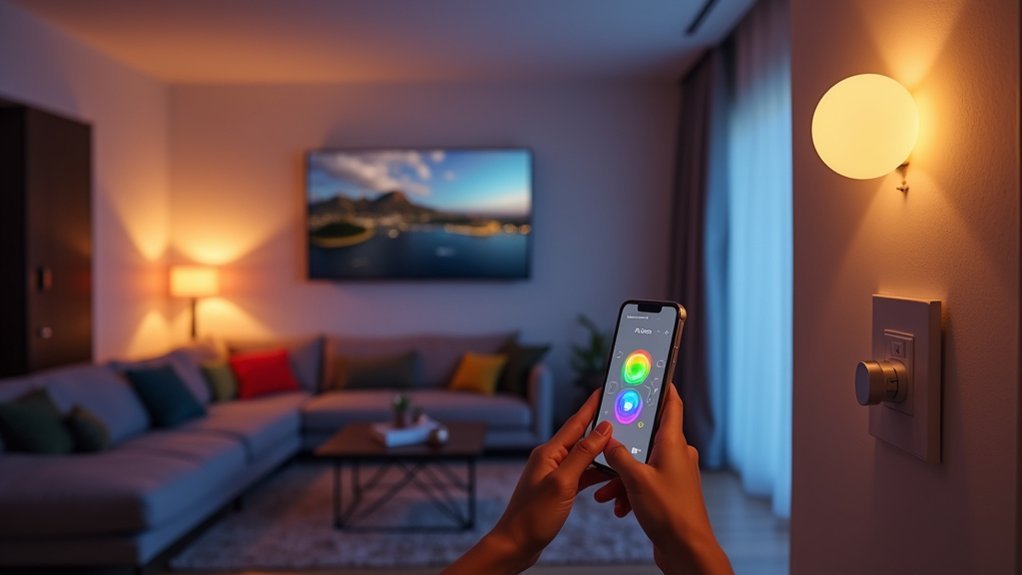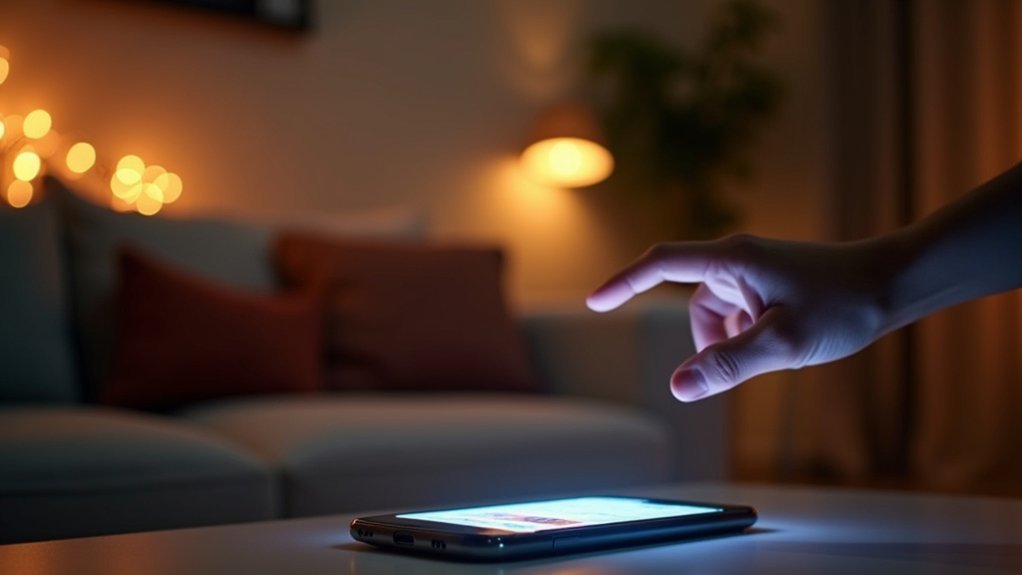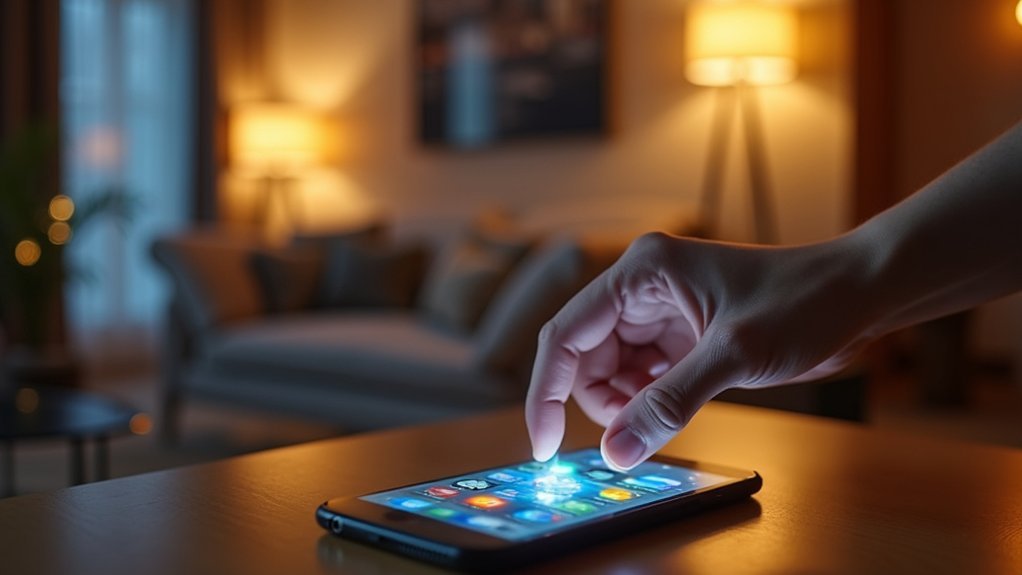To control home lights with your phone, you’ll need smart bulbs ($15 each) or smart switches ($50 each). Smart bulbs screw into existing fixtures and connect to Wi-Fi, while switches require wiring but control entire rooms. After installation, download the manufacturer’s app, create an account, and group your lights by room. You can then use voice commands via Alexa, Google Assistant, or Siri, or tap controls in the app. Discover how these simple additions can transform your home’s comfort and security.
Smart Bulbs vs. Smart Switches: Choosing Your Mobile Lighting Foundation

When entering the world of smartphone-controlled lighting, you’ll immediately face a fundamental choice: smart bulbs or smart switches. Each offers distinct advantages depending on your needs.
Smart bulbs screw into existing fixtures, connect directly to Wi-Fi, and cost around $15 each. They’re perfect for renters or those avoiding electrical work. Their color-changing capabilities create customized ambiance, but they require switches to remain on to function. Both options allow you to control lights remotely using dedicated apps like Cync from anywhere.
Smart bulbs offer hassle-free installation with no wiring needed—just screw in, connect, and enjoy customizable lighting instantly.
Smart switches replace wall switches (requiring wiring) but work with any bulb type. At about $50 each, they’re pricier upfront but more economical for fixtures with multiple bulbs.
They provide seamless control for entire rooms, maintain automation even when manually toggled, and offer a more integrated look that’s intuitive for guests.
Setting Up Your First Phone-Controlled Lighting System
Excitement builds as you prepare to transform your ordinary lighting into a smart, phone-controlled system.
Begin by selecting compatible hardware—smart bulbs for color-changing capabilities or smart plugs for a simpler, budget-friendly approach.
Before installation, always turn off power at the switch or breaker. Smart bulbs screw in like regular ones, while plugs simply connect between your lamp and outlet. For wired switches, hire a professional electrician.
Next, download your device’s dedicated app and follow the prompts to create an account. Connect your lights to Wi-Fi or Bluetooth, naming each one clearly for easy identification. Consider purchasing a dedicated hub or controller to centralize management of multiple smart lighting devices through a single app.
Group lights by room or function within the app.
Test each light individually, then experiment with group controls and basic automation rules for peak performance.
Voice Commands and Smartphone Apps for Effortless Light Control

Your smartphone transforms into a powerful lighting command center through voice assistants like Alexa, Google Assistant, or Siri.
You’ll enjoy hands-free control by simply saying phrases like “turn on the kitchen lights” or “dim the bedroom to 50%.”
Popular apps from Philips Hue, LIFX, and smart home platforms offer additional features including color customization, scheduling, and scene creation that extend beyond basic voice commands. With the Philips Hue app, you can even set up smart integrations with your home security system for enhanced functionality and convenience.
Voice Commands and Smartphone Apps for Effortless Light Control
Voice control and smartphone apps have revolutionized how we interact with home lighting systems, transforming ordinary houses into responsive smart homes. Apps like SmartThings, Philips Hue, and Tuya Smart offer remote control from anywhere while integrating seamlessly with voice assistants such as Alexa and Google Home.
These technologies provide three key benefits:
- Convenience – Control your lights without getting up or even when you’re away from home.
- Energy efficiency – Automate lighting schedules to reduce unnecessary power consumption.
- Personalization – Create custom scenes for different activities, moods, or times of day.
Users can easily manage multiple smart devices through these apps that operate via Wi-Fi or Bluetooth networks, compiling all controls in one convenient interface.
The future looks even brighter with AI integration on the horizon, which will learn your preferences and adjust lighting automatically based on your habits and needs.
Popular Voice Assistants
While numerous voice assistants compete in the smart home market, three major players dominate the landscape for light control integration. Amazon Alexa leads with the widest device compatibility and highest user adoption, while Google Assistant works with over 10,000 smart home devices including lighting controls. Apple’s Siri focuses primarily on HomeKit-enabled products. These assistants offer customizable systems that can be tailored to meet your specific household requirements and preferences.
| Assistant | Strengths | Device Compatibility |
|---|---|---|
| Alexa | Market leader, extensive compatibility | Widest range of devices |
| Google Assistant | Far-field recognition, robust routines | 10,000+ smart devices |
| Siri | Seamless Apple ecosystem integration | HomeKit-enabled only |
| Bixby | SmartThings integration | Samsung devices, plus Alexa/Google |
| Cortana | Microsoft ecosystem | Limited lighting options |
You’ll find these assistants mirrored in companion smartphone apps that enhance control options and enable remote access from anywhere.
App Control Features
Smartphone apps serve as the command center for modern smart lighting systems, putting extensive control directly at your fingertips. These intuitive interfaces allow you to create custom scenes, schedule lighting routines, and adjust brightness or color from anywhere with an internet connection.
Most lighting apps offer these essential capabilities:
- Remote access – Control your lights from anywhere, turning them on before arriving home or checking if you’ve left them on while away.
- Scene creation – Set up preset lighting configurations for different activities like movie nights, dinner parties, or relaxation.
- Voice integration – Configure your app to work with Siri, Google Assistant, or Alexa for hands-free control through simple voice commands. The market for these solutions continues to expand as affordability improves, making smart lighting accessible to more than just tech enthusiasts.
You’ll also find features for sharing access with family members and synchronizing lights with music or media content.
Creating Custom Lighting Scenes and Schedules on Your Phone

Custom lighting scenes transform your home environment with personalized settings that match your activities and moods throughout the day.
You’ll find it easy to create specific scenes like “Movie Night” with dimmed lights or “Morning Routine” with gradually brightening bulbs using your smartphone app’s intuitive controls.
These scenes can be scheduled to activate automatically at set times, ensuring your lights adjust to your daily routines without manual intervention. With the rising popularity of smart lighting systems, these customizable features have become more accessible to the average homeowner.
SUBHEADING DISCUSSION POINTS
Transforming your home lighting has never been easier with the scene creation and scheduling features available in smart lighting apps. You can define unique combinations of color, brightness, and lamp status across multiple fixtures, then save these arrangements for quick access later.
Whether you prefer gradual shifts for evening relaxation or instant changes for movie nights, these apps give you complete control.
Take advantage of scheduling to maximize convenience and security:
- Set daily routines that automatically adjust lighting based on your lifestyle—lights that dim at bedtime or brighten in the morning
- Create security schedules that simulate occupancy while you’re away
- Link lighting changes to specific triggers like sunset, motion detection, or when you arrive home
Many smart lighting systems offer energy savings through their LED efficiency and intelligent scheduling capabilities, helping reduce your electricity bills over time.
Mood-Based Scene Creation
Creating lighting scenes that capture specific moods represents one of the most exciting aspects of smart lighting control. With today’s smart bulbs offering up to 16 million colors, you can craft atmospheres that perfectly match any occasion.
For relaxation, choose warm whites at low brightness; for productivity, opt for cooler whites at higher intensity. Your phone app will guide you through selecting colors, brightness levels, and sometimes even dynamic effects like fireplace simulation or color cycling. Using the “Movie Night” scene helps create a cinematic feel with indirect lighting that minimizes glare on your TV or projector.
Apps like Philips Hue, Cync, and SmartThings provide intuitive interfaces where you can save your creations for one-touch activation. Beyond manual control, you can link scenes to voice commands, motion sensors, or other smart home triggers.
Consider color psychology when designing scenes—blues for calm, reds for energy—to effectively transform your space’s ambiance.
Time-Triggered Light Schedules
Time-triggered light schedules represent one of the most practical features of smart lighting systems, allowing you to automate your home’s illumination without constant manual adjustments.
Through apps like Cync and Smart Light Smart Home Control, you’ll create customized lighting routines that align with your daily activities.
Setting up your schedules is straightforward:
- Program sunset/sunrise triggers – Set lights to automatically activate at dusk and turn off at dawn, adapting to seasonal changes without manual updates.
- Create vacation mode scenarios – Simulate occupancy while you’re away by varying on/off patterns to enhance home security.
- Establish wake-up routines – Configure lights to gradually brighten in the morning, providing a natural, gentle start to your day.
These automated schedules not only add convenience but greatly improve energy efficiency by ensuring lights operate only when needed. With just a few clicks in the CyncApp, you can set up a user-friendly interface that makes creating and adjusting your lighting schedules simple.
Enhancing Home Security With Remote Lighting Management
While traditional security systems focus on alarms and cameras, your smartphone-controlled lighting can greatly strengthen your home’s defense against intruders.
You’ll gain the ability to create the impression someone’s home by scheduling lights to mimic occupancy patterns during absences.
When integrated with your security system, lights can automatically flood areas with brightness when alarms trigger, eliminating hiding spots and encouraging intruders to flee.
Your smartphone app enables instant control of all lights from anywhere, allowing you to illuminate exterior areas when suspicious activity occurs. Lutron’s exterior lighting options provide comprehensive coverage for all outdoor spaces, enhancing your ability to monitor your property remotely.
For maximum protection, set up your system to flash lights repeatedly during security breaches, drawing neighbor attention and helping emergency responders locate your home quickly.
This coordination between lighting and security features creates a thorough deterrent environment that considerably enhances your home’s safety.
Energy-Saving Strategies Through Mobile Light Automation
Controlling your home lighting through smartphone automation offers substantial energy-saving opportunities beyond simple convenience.
LED adoption paired with smart controls can reduce lighting energy by 7-27%, while intelligent systems deliver up to 70% savings on total lighting costs when combined with proper automation.
Your smartphone becomes a powerful energy management tool through:
- Scheduled routines – Program lights to automatically adjust based on your daily patterns, preventing wasteful usage in unoccupied rooms.
- Motion sensor integration – Guarantee lights operate only when spaces are occupied, eliminating unnecessary illumination.
- Holistic automation – Connect lighting with other smart devices like thermostats for combined savings of 5-22% on utility bills.
Smart home technology leverages wireless connectivity options like Zigbee and Z-Wave to ensure reliable communication between your smartphone and lighting systems.
Regular monitoring through app dashboards helps identify inefficiencies and fine-tune your automation for maximum conservation.
Expanding Your System: Integration With Other Smart Home Devices
Once you’ve mastered basic smartphone light control, integrating your lighting with other smart devices opens up the full potential of home automation. Choose a central hub like Josh.ai, Alexa, or Google Home that’s compatible with your existing devices to create a unified ecosystem. The complete system ensures all devices work together seamlessly for an enhanced home experience.
| Device Type | Integration Benefits | Example Automation |
|---|---|---|
| Security | Lights respond to camera detection | Porch lights activate when doorbell rings |
| Climate | Coordinated ambiance settings | Morning routine: lights on, thermostat up |
| Entertainment | Immersive experiences | Movie mode dims lights, lowers shades |
With voice commands, you can control lights hands-free or trigger custom scenes that adjust multiple devices simultaneously. Geofencing capabilities can automatically manage lights based on your location, while integration with security systems provides enhanced protection through coordinated lighting responses.
Frequently Asked Questions
Do Smart Lights Work During Internet Outages?
Some smart lights work during internet outages, especially those with local control capabilities. You’ll maintain basic on/off functionality through physical switches, while devices using Zigbee or Z-Wave protocols will continue operating without internet connection.
Can Multiple People Control the Same Lighting System?
Yes, multiple people can control the same smart lighting system. You’ll need to invite users through your app, where they’ll receive shared access permissions. Most systems support real-time updates so everyone sees current lighting status.
How Do Smart Lights Affect Bulb Lifespan Compared to Traditional Bulbs?
Your smart LED bulbs will last 15-25 times longer than traditional incandescent bulbs—up to 25,000 hours compared to just 1,000 hours. They’re also more energy-efficient, using 80% less power while generating less heat.
Are There Subscription Fees for Smart Lighting Apps?
Most smart lighting apps don’t require subscription fees for basic functionality. You’ll typically get free access to control your lights, change colors, and set schedules. Optional premium features might cost extra, but they’re rarely mandatory.
Can Smart Lighting Systems Be Installed in Rental Properties?
Yes, you can install smart lighting in rental properties. Many systems require minimal installation, use existing fixtures, and can be removed when you move, making them ideal for renters seeking energy savings and convenience.
In Summary
You’ve now got all the tools to transform your lighting setup into a smartphone-controlled system that’s convenient, energy-efficient, and secure. Whether you’ve chosen smart bulbs or switches, you’ll enjoy the freedom of controlling lights from anywhere. Don’t stop at basic functions—experiment with scenes, schedules, and integration with other smart devices to truly maximize the potential of your connected home.





Leave a Reply